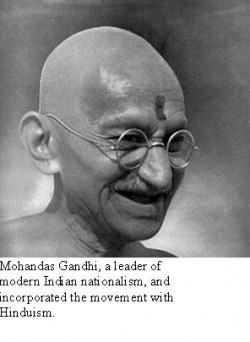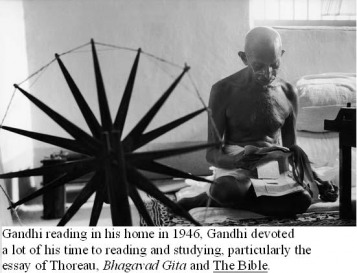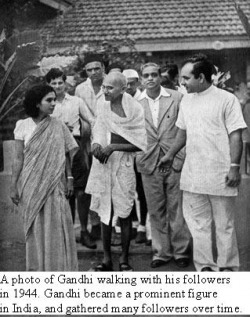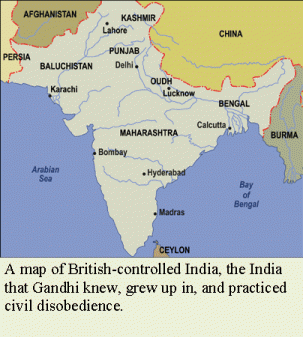Gandhi's Influences

Mohandas Karamchand Gandhi, more commonly known as Mahatma Gandhi, was an exceptional influential figure in the Indian Independence Movement. However, Gandhi adopted his tactics in achieving Indian Independence from a variety of sources. Gandhi advocated civil disobedience or non-violent, but aggressive protest or what he called satyagraha. Although Henry David Thoreau and his ideas and the Bhagavad Gita had a crucial influence on Mahatma Gandhi, and how he attained Indian Independence, the “New Testament” of the Bible had the most significant influence on him.
One person that greatly influenced Gandhi and his tactics for achieving Indian Independence was Henry David Thoreau, primarily his essay on civil disobedience. Thoreau was an early ecologist who perceived himself as a nature writer (“…‘Civil Disobedience’” 1). Thoreau was an American who opposed the United States’ invasion of Mexico during the 1840s. He demonstrated his disapproval by refusing to pay his taxes, as a protest to the Mexican War. “Thoreau placed special emphasis on the responsibilities and capabilities of the individual…he urged each man to take seriously his ability to change society for the better or worse in his daily life…Thoreau suggested in ‘Civil Disobedience’ that just and honest men should always question the role of government, and should obey its laws only when the individual deem them just” (“…‘Civil Disobedience’” 1). Gandhi, like Thoreau, spent a large quantity of time in jail for protesting causes he believed were unjust. However, both men accepted their jail time and used it to their advantage for they strongly believed in what they were fighting for.

A second source that greatly influenced Gandhi is the “New Testament” in the Bible. A particular Bible verse that greatly inspired Gandhi is in the book of “Matthew,” “‘Do not resist an evil person. If someone strikes you on the right cheek, turn to him the other also’”(NIV Bible 1540). Gandhi, although a devout Hindu, was tolerant of all religions and continuously studied the Bible along with other religious books. Gandhi believed that if one “turned the other cheek,” then overtime the enemy would have no other choice but to respect that person for their self-control. Gandhi adopted and expanded his belief in peaceful, non-violent resistance or satyagraha from the Bible, for “Jesus suggested a new, radical response to injustice: instead of demanding rights, give them up freely! According to Jesus, it is more important to give justice and mercy than to receive it” (NIV Bible 1541). Even though Gandhi advocated satyagraha, he did not support passive resistance.

A third source that significantly inspired Gandhi and his actions is the Bhagavad Gita. The Bhagavad Gita is a Hindu source that had a substantial influence on Ghandi and it became his “spiritual dictionary.” Gandhi carried the Bhagavad Gita around with him at all times. One principle of the Bhagavad Gita that influenced him was the idea of active opposition to evil. In other words if a person recognizes something he or she believes is wrong, then it is morally imperative to actively fight against that evil. If a person does not fight against it, then that person is cooperating with evil. An example of how Gandhi adhered to this principle was when he began and encouraged Indians to spin their own clothes, for it was much cheaper to produce one’s own cloth than to buy British made cloth. Gandhi’s action was published in the newspaper and it resulted in the British looking foolish to the World. Two particular words in the Bhagavad Gita fascinated him, aparigraha (nonpossession) and samabhava (equability). Gandhi’s devoutness to Hinduism as well as his studies of Christianity contributed and greatly impacted the development of civil disobedience in his thinking.
Although many people and books substantially effected Gandhi, Thoreau and his essay, The Bible, and the Bhagavad Gita were the three sources that impacted him the most.Without these influential sources, History could have been quite different. Thoreau and his essay taught Gandhi to protest and fight for things he did not believe in or things he thought were unjust, but the Bible taught him to practice self-control. The Bhagavad Gita showed Gandhi to actively oppose and fight evil, but to do so peacefully. All three resources contributed to Gandhi’s form of civil disobedience or satyagraha. Martin Luther King Jr. is an example of a person who followed in Gandhi’s footsteps in fighting for civil rights for African Americans and changed the course of history, as did Gandhi. In the end Gandhi succeeded in his enterprise, and his practices and ways of doing things continue to influence people today.
-Mara Medellin
Bibliography
“Henry David
Thoreau and ‘Civil Disobedience.’” History Study Center. 2007. ProQuest. John Cooper School Lib.,The
Woodlands, TX. 1 Apr. 2009 <http://proquest.umi.com/login>.
Life Application Study Bible: New International Version. 1978. Grand Rapids, Michigan: Zondervan, 1983.
“Mohandas
Karamchand Gandhi.” Encyclopaedia Britannica Online School Edition.
2009. Encyclopaedia Britannica. 3 Apr.
2009 <http://school.eb.com/eb/article-22635>.
Pilling, Anita. Gandhi’s Influences. World History. John Cooper School. 31 Mar. 2009.
Pictures
Bibliography
“British India.” Map. World
History: The Modern Era. 2009. ABC-CLIO. 3 Apr. 2009
<http://www.worldhistory.abc-clio.com/>
Mohandas Gandhi. Photograph. World History: The Modern Era. 2009. ABC-CLIO. 3 Apr. 2009<http://www.worldhistory.abc-clio.com/>
Mohandas Karamchand Gandhi: Gandhi
reading at home, 1946. Photograph.
1946. Encyclopaedia Britannica Online School Edition. 2009.
Encyclopaedia Britannica. 3 Apr. 2009 <http://school.eb.com/>
Mohandas K. Gandhi. Photograph. 1944. World History: The Modern Era. 2009. ABC-LIO. 3 Apr. 2009 <http://www.worldhistory.abc-clio.com/>
Timeline
- October 2, 1869: Mohandas K. Gandhi was born in Porbandar, India.
- 1882: Mohandas K. Gandhi was married to Kasturbai at the age of 13.
- September 1888: Mohandas K. Gandhi sailed to England to attend law school.
- July 1891: Mohandas K. Gandhi returned to India.
- September 1906: Indians, under Gandhi’s leadership, held a meeting at Johannesburg and pledged to defy British law and suffer the consequences, resulting in the formation of satyagraha.
- 1919: Massacre in Amritsar led to the desire for India’s complete independence from Britain.
- January 30, 1948: Mohandas K. Gandhi died in Delhi, India.

